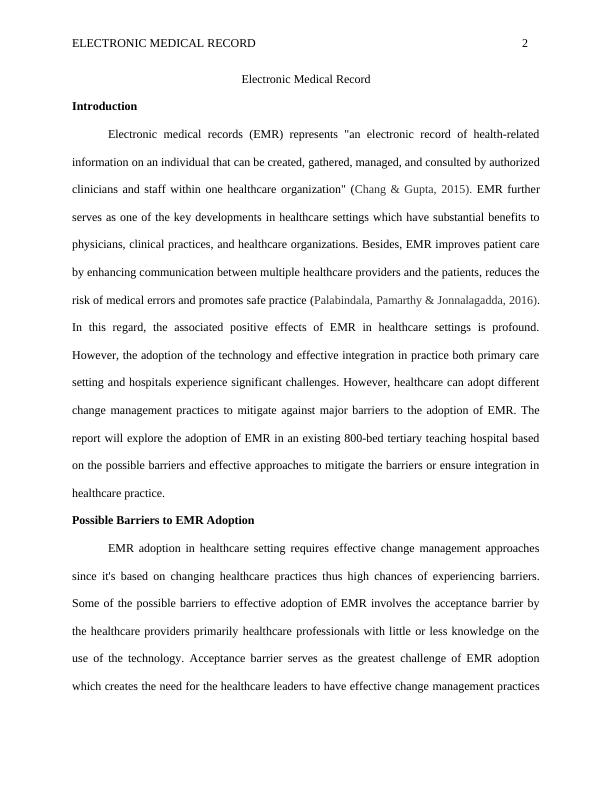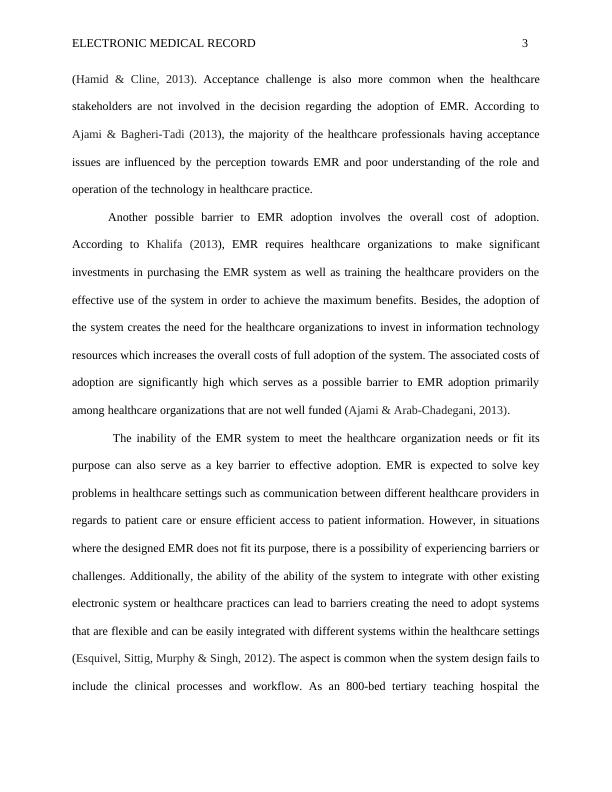Electronic Medical Records (EMR) | Assignment
9 Pages2503 Words172 Views
Added on 2020-04-01
Electronic Medical Records (EMR) | Assignment
Added on 2020-04-01
ShareRelated Documents
Running head:ELECTRONIC MEDICAL RECORD1Electronic Medical RecordNameInstitutional Affiliation

ELECTRONIC MEDICAL RECORD2Electronic Medical RecordIntroductionElectronic medical records (EMR) represents "an electronic record of health-relatedinformation on an individual that can be created, gathered, managed, and consulted by authorizedclinicians and staff within one healthcare organization" (Chang & Gupta, 2015). EMR furtherserves as one of the key developments in healthcare settings which have substantial benefits tophysicians, clinical practices, and healthcare organizations. Besides, EMR improves patient careby enhancing communication between multiple healthcare providers and the patients, reduces therisk of medical errors and promotes safe practice (Palabindala, Pamarthy & Jonnalagadda, 2016).In this regard, the associated positive effects of EMR in healthcare settings is profound.However, the adoption of the technology and effective integration in practice both primary caresetting and hospitals experience significant challenges. However, healthcare can adopt differentchange management practices to mitigate against major barriers to the adoption of EMR. Thereport will explore the adoption of EMR in an existing 800-bed tertiary teaching hospital basedon the possible barriers and effective approaches to mitigate the barriers or ensure integration inhealthcare practice.Possible Barriers to EMR AdoptionEMR adoption in healthcare setting requires effective change management approachessince it's based on changing healthcare practices thus high chances of experiencing barriers.Some of the possible barriers to effective adoption of EMR involves the acceptance barrier bythe healthcare providers primarily healthcare professionals with little or less knowledge on theuse of the technology. Acceptance barrier serves as the greatest challenge of EMR adoptionwhich creates the need for the healthcare leaders to have effective change management practices

ELECTRONIC MEDICAL RECORD3(Hamid & Cline, 2013). Acceptance challenge is also more common when the healthcarestakeholders are not involved in the decision regarding the adoption of EMR. According toAjami & Bagheri-Tadi (2013), the majority of the healthcare professionals having acceptanceissues are influenced by the perception towards EMR and poor understanding of the role andoperation of the technology in healthcare practice.Another possible barrier to EMR adoption involves the overall cost of adoption.According to Khalifa (2013), EMR requires healthcare organizations to make significantinvestments in purchasing the EMR system as well as training the healthcare providers on theeffective use of the system in order to achieve the maximum benefits. Besides, the adoption ofthe system creates the need for the healthcare organizations to invest in information technologyresources which increases the overall costs of full adoption of the system. The associated costs ofadoption are significantly high which serves as a possible barrier to EMR adoption primarilyamong healthcare organizations that are not well funded (Ajami & Arab-Chadegani, 2013). The inability of the EMR system to meet the healthcare organization needs or fit itspurpose can also serve as a key barrier to effective adoption. EMR is expected to solve keyproblems in healthcare settings such as communication between different healthcare providers inregards to patient care or ensure efficient access to patient information. However, in situationswhere the designed EMR does not fit its purpose, there is a possibility of experiencing barriers orchallenges. Additionally, the ability of the ability of the system to integrate with other existingelectronic system or healthcare practices can lead to barriers creating the need to adopt systemsthat are flexible and can be easily integrated with different systems within the healthcare settings(Esquivel, Sittig, Murphy & Singh, 2012). The aspect is common when the system design fails toinclude the clinical processes and workflow. As an 800-bed tertiary teaching hospital the

End of preview
Want to access all the pages? Upload your documents or become a member.
Related Documents
Study on Health Information Systemlg...
|10
|2510
|133
Electronic Record Keeping in Nursing and Healthcare Essay 2022lg...
|5
|832
|26
(PDF) Effectiveness of an Electronic Health Recordlg...
|20
|4897
|37
Benefits of EMR in Healthcare Systemslg...
|2
|320
|157
Health Information Systemlg...
|9
|2111
|268
Nursing Informatics - Electronic Health Recordslg...
|4
|784
|339
